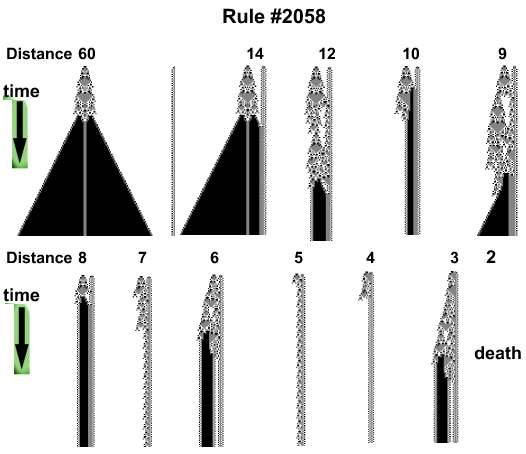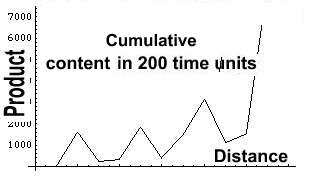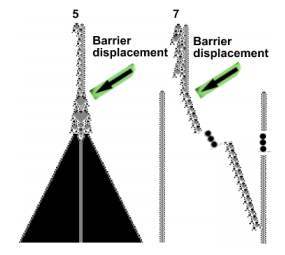 |
CA Creativity
CA2058 starts as a growing larva. In the adult stage it produces nectar (black), which is stored in a big vesicle, surrounded by a layer of nectar producing cells (epithelia). CA2058 is immortal daily two units of nectar. (Each time unit represents one day). The CA history is portrayed in the upper left corner of the image, which portrays also a gray barrier positioned 60 units from the CA seed. During the experiment the barrier was moved toward the CA seed. The numbers above the CA histories are their distances from the barrier.
 |
Barrier at distance =14: Daily nectar production
drops from two units to one (50%). This is the first indicator that CA
health declined.
Barrier at distance =12: Larva matures slower, and
starts producing nectar at an older age.Its nectar content remains constant.
Barrier at distance =10: Larva matures faster and starts producing nectar at a younger
age, yet it nectar content is low.
Barrier at distance =9: Larva matures slower and gains more cells (proliferation, hyperplasia ). Its nectar amounts to that of a CA at distance 14.
 |
The CA illustrates some important biological properties.
- Larva precedes adulthood (maturity).
- Nectar production may serve as a measure of CA's health.
- In all circumstances a CA will always attempt to mature, become an adult, and produce
nectar. If this is not achievable CA will enter a dormant state until
the barrier is removed (distance 5). This 'urge to mature' is Aristotle's
Final Cause
1. Material cause: CA structure.
2. Formal cause: Its rule
3. Efficient cause: Barrier
4. Final cause: To produce more nectar.
Barrier removal
 |
Creativity and adaptation.
The final cause requires that
the CA be creative. CA creativity is manifested in several ways:
- Accelerated maturation ( distances 8,10).
- The CA interacts with the barrier
to 'solve its problem' (distance 9) it first covers it with 'primitive cells' which
use the barrier substance for attaining adulthood. The barrier is made of
inert matter (=1), which is used by the larva to become a competent
adult.
Some (conservative) biologists, might describe the CA behavior as an ongoing adaptation to a changing environment. This is how Darwinists explain evolution of the species. Yet life is more than that! It is creative!. This hallmark of life may now be explored with cellular automata.
Further reading:
Bergson: Creative Evolution
Decline of Darwinism
Evolution theory from a new perspective
The creativity of the CA at distance = 9 may be further improved. Like by adding additional players into this small universe, mating two CA, and so on.